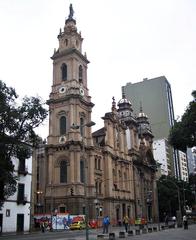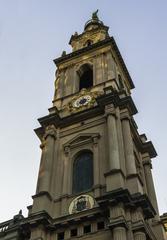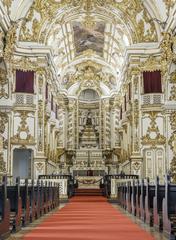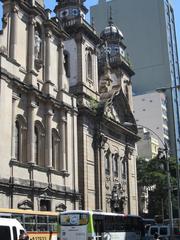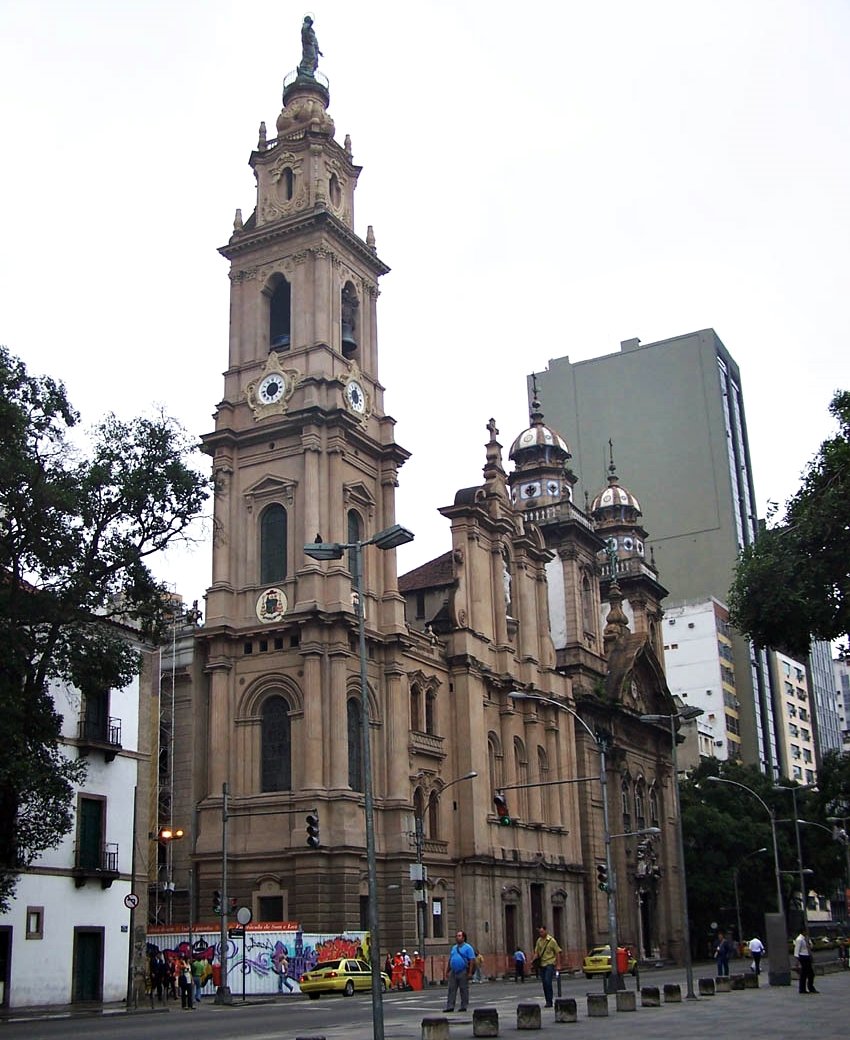
Old Cathedral of Rio de Janeiro: Visiting Hours, Tickets, and Historical Sites Guide
Date: 14/06/2025
Introduction
The Old Cathedral of Rio de Janeiro, officially known as Igreja de Nossa Senhora do Carmo da Antiga Sé, is a cornerstone of Brazil’s colonial and imperial heritage. Situated in the heart of Rio’s historic downtown, this magnificent cathedral invites visitors to explore centuries of history, artistry, and spiritual tradition. From its origins as a humble Carmelite chapel in the late 16th century to its prestigious role as the Royal and Imperial Chapel, the Old Cathedral has witnessed pivotal moments in Brazil’s national development. Today, it stands as a vibrant cultural and religious hub, drawing thousands each year for its architecture, relics, and special events like the Feast of Our Lady of Mount Carmel (Instituto do Patrimônio Histórico e Artístico Nacional, Museu Nacional de Belas Artes, Riotur).
Table of Contents
- Introduction
- Origins and Early Construction
- Royal and Imperial Chapel: Historical Milestones
- Architectural and Artistic Features
- Cultural and Religious Significance
- Visiting Hours, Tickets, and Tours
- Location, Accessibility, and Visitor Tips
- Notable Artifacts and Surroundings
- Frequently Asked Questions (FAQ)
- Summary and Final Tips
- References
Origins and Early Construction
The Old Cathedral’s story begins with the arrival of Carmelite friars in 1590, who established a small chapel dedicated to Our Lady of Mount Carmel. As Rio grew, the need for a grander structure led to the construction of the current church between 1761 and 1770, reflecting the Baroque and Rococo styles prominent in Portuguese colonial architecture (Instituto do Patrimônio Histórico e Artístico Nacional). Its central downtown location near Praça XV anchored it within Rio’s emerging urban landscape.
Royal and Imperial Chapel: Historical Milestones
The cathedral’s significance soared in 1808, when the Portuguese royal family relocated their court to Rio, fleeing Napoleon’s invasion. The church was elevated to Royal Chapel status, hosting royal ceremonies and becoming the spiritual seat of the monarchy in the Americas (Museu Nacional de Belas Artes). Following Brazil’s independence in 1822, the church became the Imperial Chapel, witnessing the coronations of Dom João VI, Dom Pedro I, and Dom Pedro II, as well as royal weddings and baptisms (Catedral do Rio). After the proclamation of the republic, its role shifted, but its symbolic importance endured.
Architectural and Artistic Features
Exterior
The cathedral showcases a blend of architectural influences, from its original Baroque façade to later Neoclassical and eclectic additions in the 20th century (Wikipedia). Carved stone portals and twin towers with tiled domes anchor the structure within the colonial and neoclassical ambiance of the Centro district (TripHobo).
Interior
Rich Rococo woodwork, crafted by Inácio Ferreira Pinto after 1785, distinguishes the interior. Notable features include:
- Gilded Altarpiece: Swirling volutes, floral motifs, and cherubs create a luminous focal point.
- Ceiling Panels: Decorated with biblical scenes and Marian iconography.
- Side Chapels: Each echoing the main altar’s intricate style.
The nave’s balconies, once reserved for the royal family, and the grand organ (installed in 1901) enhance the cathedral’s sense of history and grandeur (Wikipedia).
Art and Relics
Highlights include oval paintings of the apostles by José Leandro de Carvalho, silver liturgical objects by Mestre Valentim, the baptismal font used for royal baptisms, and Dom Pedro II’s throne. These treasures underscore the cathedral’s role as both a spiritual and cultural monument (Riotur).
Cultural and Religious Significance
The Old Cathedral continues as a focal point for religious life, especially during important festivals like the Feast of Our Lady of Mount Carmel on July 16, which attracts thousands of pilgrims each year. It remains a vital part of Rio’s cultural and civic scene, hosting concerts, special ceremonies, and educational programs (Arquidiocese do Rio de Janeiro).
Visiting Hours, Tickets, and Tours
- Opening Hours: Generally open Tuesday through Sunday, from 9:00 AM to 5:00 PM. Closed on Mondays and some public holidays. Hours may adjust for special events—verify by phone or online.
- Admission: Entry is free; donations are welcome to support restoration.
- Guided Tours: Available on request at the cathedral or via local operators. Tours in Portuguese are frequent; English and Spanish may be available. Booking in advance is recommended.
- Photography: Permitted (without flash), but please respect religious services.
Location, Accessibility, and Visitor Tips
- Address: R. Sete de Setembro, 14 - Centro, Rio de Janeiro - RJ, 20050-009, Brazil.
- Public Transit: Nearest metro stations are Cinelândia and Carioca; multiple bus lines serve the Centro district (TourbyTransit).
- Accessibility: Wheelchair accessible via main entrance ramps; accessible restrooms available. Some uneven floors may present challenges—contact staff in advance for assistance.
- Dress Code: Modest attire required; shoulders and knees covered, hats removed.
- Best Time to Visit: Mornings are quieter and offer the best light for photos. Saturdays feature a lively flea market at Praça XV, adding to the local atmosphere (TourbyTransit).
- Safety: The Centro district is safe during the day; use common sense urban precautions and avoid isolated areas after dark (ChewsToExplore).
Notable Artifacts and Surroundings
Inside the cathedral, don’t miss:
- The royal baptismal font, symbolizing dynastic continuity.
- Dom Pedro II’s throne, a tangible link to Brazil’s imperial era.
- The Golden Rose, a papal honor awarded to Princess Isabel for her role in the abolition of slavery.
- Artwork by Mestre Valentim and Manoel da Cunha.
Located near the Imperial Palace and Fiscal Palace, the cathedral anchors the historic core of Rio, making it an ideal starting point for a walking tour of the city’s colonial landmarks (Rio Cultural Secrets).
Frequently Asked Questions (FAQ)
Q: What are the Old Cathedral of Rio de Janeiro visiting hours?
A: Typically Tuesday–Sunday, 9:00 AM to 5:00 PM; closed Mondays and some holidays.
Q: Is there an entrance fee?
A: No, admission is free. Donations are appreciated.
Q: Are guided tours available?
A: Yes, on request at the cathedral or through tour operators.
Q: Is the cathedral wheelchair accessible?
A: Yes, via ramps at the main entrance; interior accessibility is good, though some areas have uneven flooring.
Q: Can I take photos inside?
A: Yes, non-flash photography is allowed except during religious ceremonies.
Q: What is the best time to visit?
A: Early mornings or late afternoons for less crowding and optimal lighting.
Summary and Final Tips
The Old Cathedral of Rio de Janeiro is a testament to Brazil’s layered history, architectural brilliance, and enduring spiritual traditions. From its Baroque and Rococo artistry to its role as the site of royal coronations and ceremonies, the cathedral offers a unique educational and cultural experience. With free admission, central location, and accessibility features, it welcomes all visitors. Enhance your visit by joining a guided tour, attending a special event, or utilizing digital resources like the Audiala mobile app for up-to-date information and self-guided narratives.
For the most rewarding experience, plan your visit during quieter hours, dress respectfully, and explore the surrounding historical district. Stay informed about restoration projects and upcoming events by following official tourism channels and social media.
Embark on a journey through Brazil’s past at the Old Cathedral of Rio de Janeiro—where history, art, and spirituality meet in the heart of the city (Visit Brasil, Riotur, Rio Cultural Secrets).
